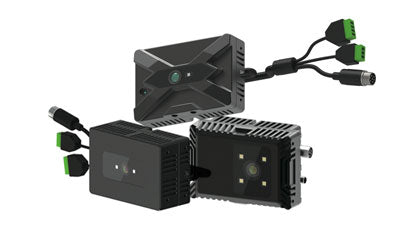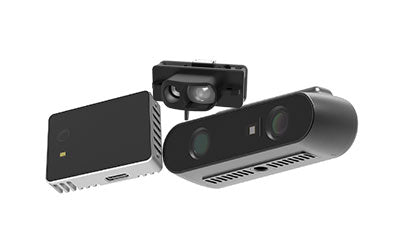How ToF 3D Sensors Transform Smart Warehousing and Path Planning

How Does ToF Technology Improve Robot Navigation and Path Planning in Smart Warehousing?
What is Logistics Intelligence?
Logistics Intelligence refers to the capability to optimize, predict, and support decision-making in logistics and supply chain management through data collection, analysis, and intelligent algorithms. It includes not only real-time monitoring of transportation, warehousing, and distribution processes but also path optimization, inventory management, demand forecasting, and automated scheduling using technologies such as big data analytics, artificial intelligence, and the Internet of Things (IoT).
In simple terms, logistics intelligence leverages technology and data to make logistics systems more efficient, flexible, and predictable, thereby reducing costs, improving operational efficiency, and enhancing customer experience.
1. Background: New Path Planning Requirements in the Era of Intelligent Warehousing
With the rapid development of intelligent logistics and automated warehousing systems, modern warehouses place unprecedented demands on robots and automated handling equipment. Today, widely deployed devices such as AGVs (Automated Guided Vehicles), AMRs (Autonomous Mobile Robots), and unmanned forklifts not only need to transport goods but also require autonomous navigation, path optimization, and real-time obstacle avoidance capabilities to cope with increasingly complex warehouse environments.
Traditional sensing solutions, such as ultrasonic sensors, infrared sensors, or 2D LiDAR, provide basic navigation in simple environments. However, in modern warehouses with dense shelving, narrow aisles, and dynamically changing obstacles, these solutions face significant limitations. They often fall short in depth resolution, distance accuracy, field of view coverage, and response speed to dynamic obstacles, making it difficult to meet the requirements for highly efficient automated handling.
At this point, TOF (Time-of-Flight) technology provides a reliable environmental perception solution for warehouse robots, offering millisecond-level real-time distance measurement and high-precision 3D depth perception. By emitting light pulses and measuring their reflection time, ToF cameras can quickly generate a complete 3D depth map of the surrounding environment, enabling real-time detection of shelves, goods, floor obstacles, and moving personnel.
With ToF technology, intelligent warehouse robots can achieve high-precision path planning, dynamic obstacle avoidance, goods recognition, and accurate positioning in dynamic environments. This not only improves the safety and efficiency of handling tasks but also provides visualized data support and intelligent scheduling for warehouse management systems. In essence, ToF has become a core technology for robot navigation and path optimization in modern intelligent warehousing, driving logistics toward high efficiency, automation, and intelligence.
2. The Core Role of ToF Technology in Warehouse Path Planning
1. Real-Time Obstacle Avoidance and Dynamic Navigation
In modern intelligent warehouses, real-time obstacle avoidance and dynamic navigation are critical for the safe and efficient operation of AGVs and mobile robots. ToF (Time-of-Flight) cameras emit light pulses and measure their return time to rapidly generate high-precision 3D depth maps, providing robots with instant perception of their surrounding environment.
Using ToF technology, warehouse robots can detect various obstacles in real time, including moving personnel, irregularly stacked goods, and temporarily placed tools or equipment, enabling millisecond-level dynamic obstacle avoidance. Compared to traditional 2D LiDAR, ToF offers a wider field of view (FoV) and higher depth resolution, allowing robots to navigate reliably in narrow aisles, high shelving areas, and complex intersections.
Additionally, ToF perception systems support path replanning. When a robot detects that a path is blocked or the environment changes, it can quickly calculate an alternative route, ensuring continuous operation and avoiding downtime or collisions. Combined with modern algorithms such as dynamic planning and 3D SLAM (Simultaneous Localization and Mapping), robots can not only avoid obstacles accurately but also maintain optimal travel routes in dynamic environments, significantly enhancing warehouse operation efficiency and safety.
Overall, ToF technology provides mobile robots in intelligent warehouses with real-time environmental perception, flexible obstacle avoidance, and dynamic navigation capabilities, making it a key enabler of efficient and automated logistics.
2. Goods Recognition and Accurate Positioning
In modern intelligent warehouses, goods recognition and accurate positioning are critical for automated sorting and handling. By combining ToF depth sensing technology with AI image recognition algorithms, warehouse systems can achieve 3D spatial perception and intelligent identification of goods.
Specifically, ToF cameras can rapidly generate high-precision 3D depth maps of goods and their surrounding environment, accurately measuring height, volume, and shape. Coupled with AI algorithms, the system can recognize stacking status, packaging types, and the position relationship between goods and pallets. This provides reliable input for automated sorting robots, allowing them to select appropriate picking strategies based on actual goods, avoiding collisions and handling errors.
Furthermore, ToF technology assists robotic arm end-effector positioning. When picking or placing goods or handling pallets, depth data helps the robotic arm calculate the exact grasping point and angle, significantly improving operation accuracy and success rate. For multi-layered or irregularly shaped goods, ToF sensors can determine picking height and orientation in real time, reducing handling failures and enhancing operational efficiency.
By integrating intelligent algorithms, the system can also enable automatic pallet recognition and dynamic task scheduling. When multiple robots work simultaneously, ToF data helps the system understand the position of goods and pallets in real time, coordinate handling, and optimize sorting paths, further improving overall warehouse efficiency.
In summary, ToF depth sensing technology not only enhances handling precision and sorting efficiency but also provides a solid data foundation for the fully automated operation of intelligent warehouse systems.
3. Automated Handling and Path Optimization
In modern intelligent warehouses, ToF (Time-of-Flight) technology plays a core role not only in environmental perception but also in automated handling and path optimization. Its advantages include:
-
Real-Time 3D Mapping and Autonomous Navigation
ToF cameras generate high-precision 3D depth maps in real time, allowing warehouse robots to perceive the full layout of the warehouse. Combined with 3D SLAM (Simultaneous Localization and Mapping) technology, robots can navigate autonomously in complex aisles and dynamic environments without relying on fixed paths or markers. Even if temporary obstacles or changes in cargo placement occur, the robots can quickly update maps and perform real-time path adjustments. -
Dynamic Path Optimization and Energy Efficiency
By processing ToF data with deep learning algorithms, the system can intelligently analyze aisle congestion, task priorities, and robot status to generate optimal paths. During handling tasks, robots can adjust routes automatically based on environmental changes, avoiding delays or excessive detours, achieving high-efficiency handling with low energy consumption. -
Handling Accuracy and Collaborative Operations
ToF technology provides precise positioning of goods, allowing robots to operate accurately during picking, placing, and stacking. By integrating with the warehouse management system (WMS), robots can intelligently assign tasks and optimize operation sequences, enabling multi-robot collaborative handling and improving overall warehouse efficiency. -
Intelligent Scheduling and Long-Term Optimization
Over long-term operation, ToF data can be used to analyze warehouse layout, cargo flow, and robot scheduling efficiency, providing data-driven optimization solutions. This not only improves path planning but also guides warehouse layout adjustments, achieving intelligent and sustainable warehouse operations.
In summary, ToF technology builds a system for warehouse robots to operate autonomously, efficiently, and with low energy consumption through real-time 3D perception, dynamic obstacle avoidance, accurate positioning, and intelligent path planning, making it an indispensable core technology in modern intelligent warehousing.
3. Technical Challenges: Issues Faced by ToF in Warehouse Applications
Although ToF (Time-of-Flight) technology shows great potential in intelligent warehousing and logistics automation, it still faces a series of technical challenges in real-world applications. These challenges require comprehensive solutions in hardware design, algorithm optimization, and system integration.
-
Occlusion and Reflection Issues
Warehouses contain numerous metal shelves, plastic packaging, and transparent materials, which can cause strong reflections, multipath interference, or signal scattering, affecting depth measurement accuracy. For instance, when a light pulse encounters a metal surface, multiple return paths may occur, resulting in depth map errors. To address this, strategies such as multi-point sampling, signal filtering algorithms, and material reflection modeling are typically employed to improve measurement reliability. -
Complex Environmental Conditions
Dust, temperature and humidity fluctuations, and lighting changes in warehouses can all impact ToF camera performance. Dust and haze can attenuate light pulses, while strong light or direct sunlight may interfere with photodetectors, causing noise or deviations in depth data. This necessitates environmental adaptation capabilities, such as dynamic exposure control, background light suppression algorithms, and temperature compensation mechanisms, to ensure stable operation under variable conditions. -
System Latency and Data Processing Pressure
High-resolution ToF cameras generate massive amounts of data, potentially producing millions or even tens of millions of depth points per second. If processor performance is insufficient or algorithms are not optimized, path planning and obstacle avoidance computations may be delayed, affecting the robot’s real-time response. In complex warehouse scenarios, such delays can directly impact safety and operational efficiency. To address this, the industry increasingly adopts FPGA parallel computing, GPU acceleration, and deep learning-based denoising and point cloud compression algorithms to ensure real-time and accurate data processing.
To overcome these challenges, modern warehouse systems are actively adopting high-performance ToF chips (e.g., VCSEL + SPAD architecture) combined with AI-enhanced algorithms, parallel computing platforms, and multi-sensor fusion. Through coordinated optimization of hardware and software, systems can maintain high-precision depth perception, low-latency response, and robust navigation capabilities in complex environments, providing reliable support for AGVs and automated handling robots.
4. Recommendations for Warehousing and Logistics Operators: How to Use ToF to Improve Automation Efficiency
-
Integrate AI Algorithms for Autonomous Decision-Making
Combine ToF depth sensing with AI to enable robots to learn and predict their environment autonomously, reducing reliance on manual calibration. -
Adopt Multi-Sensor Fusion Solutions
Fuse ToF data with LiDAR, IMU inertial navigation, and RGB cameras to achieve multi-modal perception and higher positioning accuracy. -
Modular Design with Expandable Interfaces
Choose ToF modules that support interfaces such as MIPI, USB, or Ethernet, facilitating integration into various types of AGVs, AMRs, or unmanned forklifts. -
Algorithm Optimization and Edge Computing
Use embedded SoC chips or edge AI computing platforms for real-time data processing, reducing cloud latency and improving system responsiveness. -
5G and Cloud Platform Collaboration
Leverage low-latency 5G communication and cloud-based scheduling platforms to enable multi-robot collaboration and path sharing, improving overall warehouse efficiency.
5. Future Outlook: ToF + AI + 5G Building a New Intelligent Warehousing Ecosystem
With the continuous advancement of AI algorithms, 5G communications, and semiconductor chip technology, future intelligent warehouse systems will form a full-space perception network centered on ToF:
-
ToF + AI Integration: Achieve more precise scene understanding, intelligent sorting, and automated handling;
-
ToF + 5G Collaboration: Enable low-latency data transmission and real-time multi-device cooperation;
-
ToF + Cloud Computing and Digital Twins: Build virtual warehouse models for intelligent scheduling and global optimization.
In the future, ToF-based 3D visual perception systems will no longer be just distance measurement tools, but will serve as the central nervous system of intelligent logistics and warehousing, driving the industry toward unmanned, intelligent, and highly efficient operations.
-
Posted in
CS40P





